日本在台湾的殖民统治经济发展日本在台湾的殖民统治解读
近代日本殖民统治下的台湾社会发展

近代日本殖民统治下的台湾社会发展近代日本殖民统治下的台湾社会发展是一个曲折而复杂的历史过程。
从1895年日本通过《马关条约》强行割让台湾开始,到1945年二战结束时台湾恢复中华民国统治,这段时间里,日本对台湾进行了长达50年的统治。
这段时间里,台湾经历了社会、经济、教育、文化等方面的巨大变迁和冲击。
本文将从社会、经济和教育等方面论述近代日本殖民统治下的台湾社会发展。
首先,近代日本殖民统治对台湾社会产生了深刻影响。
在殖民统治初期,日本加强了对台湾的行政管理和社会控制。
他们通过引进现代化制度、改善基础设施建设、发展产业等手段,推动了台湾的现代化进程。
例如,日本在台湾修建了铁路和港口,加强了交通运输和贸易发展。
这为台湾的经济发展提供了契机,也改善了台湾民众的生活条件。
其次,近代日本殖民统治对台湾经济产生了重大影响。
日本统治下,台湾经济由传统农耕经济向现代工业经济转型。
日本殖民政府通过改良农业、引进种植业和工业技术、加强基础设施建设等手段,促进了台湾产业结构的转变。
他们大量引进西方现代化技术和管理经验,推动了台湾的工业发展。
在这个过程中,台湾的制造业、制糖业、纺织业等迅速发展,成为亚洲地区的重要经济中心之一。
然而,近代日本殖民统治带来的经济发展并非一帆风顺。
日本对台湾的统治主要是为了满足本国经济利益和军事需求,台湾被视为资源和市场的延伸。
殖民统治下,日本政府将台湾作为经济开发和农业生产的后方基地,进行大规模的资源掠夺。
例如,台湾的林业资源被大量开发,导致森林资源枯竭,环境恶化。
此外,殖民统治还导致了土地集中、农民贫困等问题。
另外,近代日本殖民统治对台湾的教育体制和文化发展也产生了深远影响。
日本殖民政府在台湾实施教育改革,推广日本的教育制度和文化价值观。
他们建立了以日本为标杆的教育体系,派遣日本教师到台湾教育机构任教,并强迫台湾居民学习日语和日本文化。
这导致了台湾的教育体系和文化传统受到了严重扭曲,也引发了台湾居民对日本殖民统治的抵制情绪。
日本殖民统治台湾的政治制度
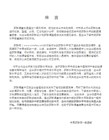
(6)以上显示:各级地方行政机关始终欠缺自主权和自治权,而深具官治主义和从属性色彩,行政官员完全是在上级机关指挥监督下,执行法律命令和处理行政事务,街、庄、社长和区长不具官吏资格,无固定俸给,仅支给事务费,以协助行政事务,全然异於日本国内的地方自治制度。
三、警察的任务与特色
1895年总督府成立后,内务部内设有警保课,主管警察保安事务,其任务有卫生和户口调查。1898年,总督儿玉源太郎进行改革警察制度,在各地大量增设派出所,将维持治安的任务完全委诸警察,采用保甲制度作为警察的辅助机关,因为日本人是以少数人来统治多数的台湾人,警察就成为台湾殖民政策执行重心,日本殖民统治时期,警察权力可说无所不在,警察权不断扩大而至於无所不管。警察权力如下:
(1)调查户口,监视出入者
(2)搜查土罪,预防传染病
(3)修桥舖路,预防虫
亦有由保甲中十七岁至四十岁的男子,组成“壮丁团”,保甲及壮丁团经费均由保甲内容各户负担,总督府因此节省巨额的行政费。保甲成立之初,主要作为政治和社会控制工具,是警察行政的辅助机关,在警察指挥下,维持地方秩序,另一方面也制定保甲规约,订有“刑罚连坐责任”,使保甲成员日常生活,行动完全在控制之中。随著社会新秩序的建立和安定,保甲的功能转向辅助基层行政工作,凡是民政、建设、交通、纳税等一般行政事务,也在其服务范围内,总督府也利用保甲协助放足、断髮、推广日语等运动,可见保甲是总督府行政动员的重要工具
约可分为下列几个原因:
(1)原敬内阁诞生,是一个政党内阁,与原来官僚内阁不同
(2)受到美国总统威尔逊所提「民族自决」的影响
(3)俄国出现苏维埃政权,支持各地殖民地的反抗独立运动
(4)台湾内部的武装抵抗已改成温和的方式
所以由於国内外形势的改变,日本被迫修改殖民地政策,改设文官总督,推行「同化主义」,消除差别待遇,在这一时期,推动一连串温和改革:
50年的殖民统治,日本在台湾干了什么?
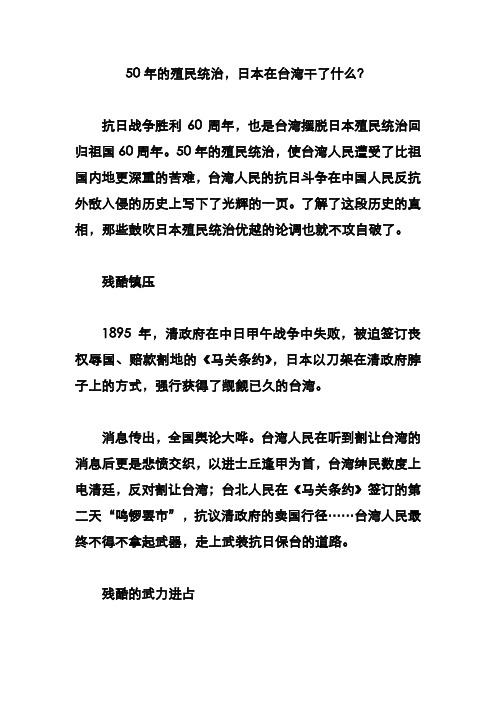
50年的殖民统治,日本在台湾干了什么?抗日战争胜利60周年,也是台湾摆脱日本殖民统治回归祖国60周年。
50年的殖民统治,使台湾人民遭受了比祖国内地更深重的苦难,台湾人民的抗日斗争在中国人民反抗外敌入侵的历史上写下了光辉的一页。
了解了这段历史的真相,那些鼓吹日本殖民统治优越的论调也就不攻自破了。
残酷镇压1895年,清政府在中日甲午战争中失败,被迫签订丧权辱国、赔款割地的《马关条约》,日本以刀架在清政府脖子上的方式,强行获得了觊觎已久的台湾。
消息传出,全国舆论大哗。
台湾人民在听到割让台湾的消息后更是悲愤交织,以进士丘逢甲为首,台湾绅民数度上电清廷,反对割让台湾;台北人民在《马关条约》签订的第二天“鸣锣罢市”,抗议清政府的卖国行径……台湾人民最终不得不拿起武器,走上武装抗日保台的道路。
残酷的武力进占1895年5月25日,丘逢甲、林朝栋等台湾士绅宣布成立“台湾民主国”,推清政府台湾巡抚唐景崧为总统,设议院、筹防局和团练局,准备不奉清廷号令,自主抗日,但同时又以“蓝地黄虎旗”为国旗,定国号为“永清”,以表示永远心向大清之意。
民主国以南部刘永福率领的黑旗军最为有名,结合地方人士自发组织的义军,有力地打击了前来接收台湾的日本殖民者。
《马关条约》签订后,日本以海军大将桦山资纪为台湾首任总督,并派北白川能久亲王率领近卫师团武力接收台湾。
日军军舰到达淡水港附近,遭到了守军的强烈抵抗,日军见淡水港不易攻下,便改由三貂角附近的澳底登陆,6月2日日军占领基隆炮台。
同一天,清朝代表李经芳与桦山资纪正式签订割台协议。
唐景崧、丘逢甲等民主国的领导者见情势危急,纷纷内渡。
领导中心一失,台北城内便陷人了混乱……日军拿下台北城后,于6月17日在巡抚衙署举行总督府始政仪式,宣布开始统治,这个日子被日人设为“台湾始政纪念日”。
然而,日军向南部推进时却遭到了刘永福率领的黑旗军与各地抗日义军的顽强抵抗。
在桃园、新竹、苗栗,义军与日军的战斗都相当惨烈,六七月间,义军一度反攻新竹,歼灭日本骑兵于大湖口,刘永福也派吴彭年率黑旗军北援,在新竹、苗栗一带与日军相持一个多月。
1925年台湾与大陆分离的原因
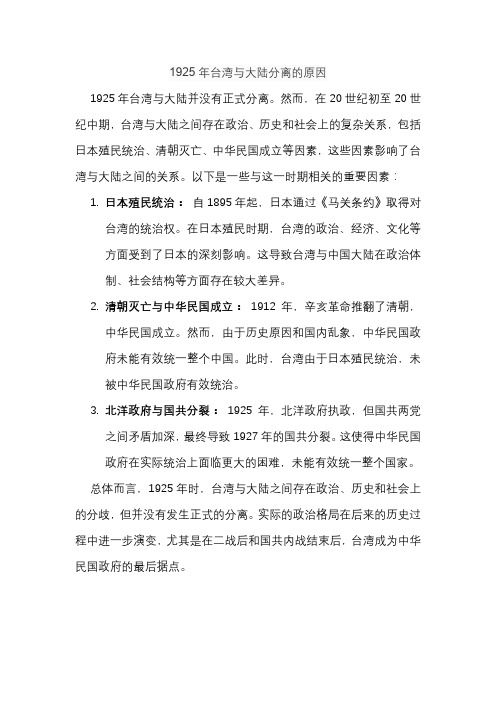
1925年台湾与大陆分离的原因
1925年台湾与大陆并没有正式分离。
然而,在20世纪初至20世纪中期,台湾与大陆之间存在政治、历史和社会上的复杂关系,包括日本殖民统治、清朝灭亡、中华民国成立等因素,这些因素影响了台湾与大陆之间的关系。
以下是一些与这一时期相关的重要因素:
1.日本殖民统治:自1895年起,日本通过《马关条约》取得对
台湾的统治权。
在日本殖民时期,台湾的政治、经济、文化等方面受到了日本的深刻影响。
这导致台湾与中国大陆在政治体制、社会结构等方面存在较大差异。
2.清朝灭亡与中华民国成立:1912年,辛亥革命推翻了清朝,
中华民国成立。
然而,由于历史原因和国内乱象,中华民国政府未能有效统一整个中国。
此时,台湾由于日本殖民统治,未被中华民国政府有效统治。
3.北洋政府与国共分裂:1925年,北洋政府执政,但国共两党
之间矛盾加深,最终导致1927年的国共分裂。
这使得中华民国政府在实际统治上面临更大的困难,未能有效统一整个国家。
总体而言,1925年时,台湾与大陆之间存在政治、历史和社会上的分歧,但并没有发生正式的分离。
实际的政治格局在后来的历史过程中进一步演变,尤其是在二战后和国共内战结束后,台湾成为中华民国政府的最后据点。
日本对台湾的殖民统治政策及其影响
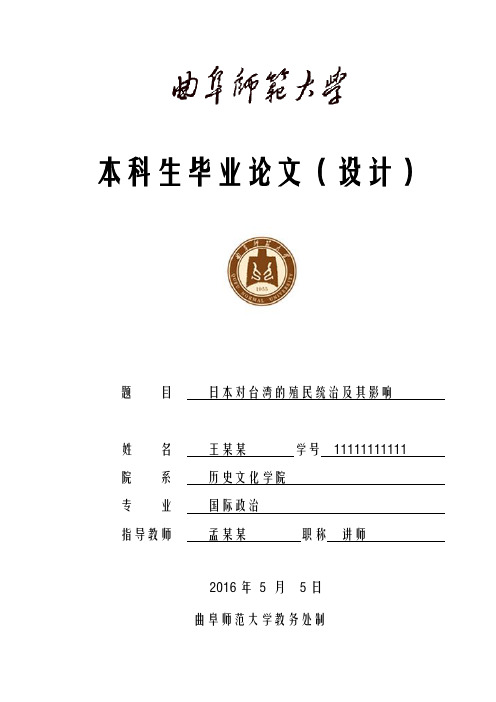
本科生毕业论文(设计)题目日本对台湾的殖民统治及其影响姓名王某某学号11111111111院系历史文化学院专业国际政治指导教师孟某某职称讲师2016年5 月5日曲阜师范大学教务处制目录摘要 (1)关键字 (1)引言 (1)一、日本对台湾的殖民统治政策 (1)(一)政治方面 (1)1.总督制 (2)2.警察制度 (2)3.保甲制度 (2)(二)文化方面 (2)1.皇民化运动 (2)2.差别教育 (3)(三)经济方面 (4)1.“日台经济一体化” (4)2.台湾“基地化” (5)二、日本对台湾殖民统治政策的影响 (5)(一)对日本政府的影响 (5)(二)对中国的影响 (5)(三)对台湾地区的影响 (5)三、增强综合国力 (6)四、结语 (6)致谢 (6)参考文献: (7)日本对台湾的殖民统治政策及其影响国际政治专业王新新指导教师孟凡礼摘要:1895年甲午中日战争爆发,日本在甲午战后占领了台湾地区,日本把台湾作为了其国家的殖民地。
日本占领台湾并进行殖民统治的过程中,在政治、经济上日本对台湾实行了一系列的政策如:政治方面日本实行总督专制,再加上一系列的高压政策如:保甲制度、警察制度等;“日台经济一体化”是日本殖民当局在经济方面实行的政策,从而达到台湾经济为日本经济服务的目的;在文化方面日本对台湾地区实行了同化政策,并进行差别教育,从而达到使湾地区的人民无条件服从日本的目的。
日本政府对台湾地区实行的一系列的殖民统治政策,使台湾地区的经济、政治和文化等方面都产生了非常恶劣的影响,甚至其影响程度一直延续到今天中日关系的发展。
关键字:日本;台湾;殖民统治The colonial rule of Japan and its influence on TaiwanInternational political professional WangXinxinTutor MengFanliAbstract:the outbreak of the Sino Japanese war in 1895, Japan after the Sino Japanese War of 1894-1895 occupied the area of Taiwan, Japan to Taiwan as a colony of the country. Japanese occupation of Taiwan and colonial rule, in the political and economic Japan to Taiwan's implementation of the a series of policies such as political Japan governor autarchy, coupled with a series of high handed policy such as BaoJia system, police system; "Japan and Taiwan economic integration" is practiced in the Japanese colonial authorities in economic policy, to Taiwan's economy for the purpose of the Japanese economy service; culture in Japan to Taiwan area to implement the policy of assimilation and difference in education, so as to achieve the bay area people unconditional obedience to Japan. The Japanese government on Taiwan implemented a series of policy of colonial rule, Taiwan's economy, politics and culture has produced a very bad impact, even the influence degree has been extended to the development of Sino Japanese relations today.Keywords: Japanese;Taiwan;colonial rule in引言:在现实因素和历史因素的综合作用下,台湾问题成为了一个关乎中国国家核心利益的问题,具有复杂的国际背景。
第五讲 日治时期的台湾

1895年始在台湾设警察。到1898年时人数增至 3375人,始终以日人为主体,1907年始录用台 湾人,但人数较少。
职能:“一切政务皆由警察官施行,协助处理 地方厅政务支厅长以下的官吏多为警察官;特 别事物为保甲,鸦片户口、刑决、收官、卫生、 税揖等的处理。
在台湾,民警比例为547:1;日本为1228:1; 朝鲜为919:1(1922年的统计数据),1902年, 警察费为当时民政费的44.8%。
(3)人力管制
主要为解决台湾在战时对技术人员和熟练 工人的奇缺状况,并适用战争需要。但在 实行中却并不重技术教育而重精神教育, 以培养台湾人的“日本人格”。
(4)战时经济统制的阶段及成效
①1931——1935年,1934年日月潭水电厂竣工, 促进了耗电巨大的炼铝,炼钢,化工工业的发展, 改变了以前单一制糖业的格局。农业方面发展多 种作物种植,如棉花,麻类,咖啡,可可等,单 一农业产品格局打破。
– 保甲制度
1898年8月,总督府颁发保甲条例,1903年5月, 制定保甲条例实施细则,全岛居民以十户为一 甲,十甲为一保,保甲内居民负有连带责任。 保甲须成立壮丁团,负责防范“匪徒”及各种 家害。接受警察官的指挥。这条例成为日本殖 民者控制人民的基本条规。
此后,保甲组织从警察辅助机关转为一般行政 辅助机关。
1907年实施三一法,与六三法无本质区别,只不 过增加了一条:台湾总督发布的律令不得违反在 台湾施行的日本法律和赦令。从此,台湾总督集 立法、行政、军事大权于一身,实施专制独裁统 治。
1921年颁布法律第三号,(简称法三号),目的 在于消除台湾特性,同化台湾,使之成为日本帝 国真正的领土和臣民。对总督权力予以一定限制, 即只有在台湾地方需要而日本国内法律尚无明确 规定时,总督才拥有律令权,同时扩大总督府评 议会规模。但其专制权力未变。
台湾历史教科书近代史

台湾历史教科书近代史近代史是台湾历史上一个十分重要的时期,也是学习台湾历史的重要部分。
台湾的近代史始于19世纪末,经过了多次战争、政治转型和社会变革,对于理解台湾的现代化历程具有不可或缺的重要意义。
下文将从教科书的角度来探讨台湾近代史内容的主要特点。
一、台湾近代史的概述首先,台湾的近代史可以分为三个阶段:清代末期的时期、日本殖民统治时期和国共斗争时期。
在这三个时期里,台湾的政治、经济、文化都发生了重要的变化。
其中,清末时期的反抗运动和日本殖民统治时期的社会改革和经济发展,是台湾近代化历程中最为重要的时期。
二、清末时期的反抗运动清朝末年,由洋务派和保守派争权夺利,导致政治和经济形势都日益恶化。
1895年,清朝政府签订《马关条约》把台湾割让给日本,引发台湾人民的强烈反抗。
当时的领袖孙中山发动了多次反抗运动,在群众中营造了强烈的反日情绪。
这一时期的反抗运动成为了台湾历史上一个不可忽略的部分,也是台湾人民意识形态和民族意识形成的重要条件。
三、日本殖民统治时期1895年,台湾被日本统治。
在日本的殖民统治下,台湾社会发生了很大的变化,社会基础设施建设、教育、文化都得到了很大的发展。
同时,也对台湾自然环境和土地利用带来了深远的影响。
在日本殖民统治时期,台湾社会的现代化进程得到巨大的推进,但同时也有种族歧视、文化压迫的问题。
四、国共斗争时期在国共斗争时期,台湾的政治状况出现了重大转折。
1949年,中国内战胜利后,中国国共党政权迁离大陆,逃至台湾。
此后,台湾开始了新的政治统治时期,政治结构和社会发展进程也发生了很大的变化。
当时,台湾的历史教科书也开始强调台湾民族独特性,强化对于中国的分离和独立的呼声。
总之,台湾的近代史是台湾历史上一个十分重要和特殊的时期,其内容和发展都影响了台湾的现代化历程和国家发展。
在历史教育中,需要全面地掌握和理解这段历史,以帮助学生更好地理解台湾的现代化历程和人文精神。
近代日本的殖民政策对东南亚的影响

近代日本的殖民政策对东南亚的影响日本在19世纪末和20世纪初期迅速成为一个大国,并在追求国家利益的过程中对周边国家展开殖民统治。
特别是在东南亚,日本的殖民政策对当地国家产生了深远的影响。
日本在东南亚的殖民统治开始于1895年,当时该国从中国接管了台湾。
在此后的几年里,日本成功地将其控制区域扩展到了朝鲜和中国的东北部。
这样的进展使日本的政治和经济实力得到大幅增强,其海军也日益强大。
1905年,日本在对俄罗斯的战争中获胜,这使得该国成为了亚洲唯一的大国,并展现了它的雄心。
随着对亚洲各地的控制扩张,日本寻求在全球舞台上享有更高的地位。
这种殖民主义政策扩展到了东南亚地区,在此期间,日本海军将其重点转向了太平洋。
1929年,日本军队侵入中国东北三省(奉天、吉林、辽宁),并在1931年宣布该地区成为“满洲国”。
这种侵略触及到了国际社会,特别是欧美国家,这导致日本在国际舞台上备受批评和孤立。
但在同一时期,日本东南亚的计划得到了佐藤内阁和其他一些上层领导人的强力支持。
日本在印度支那,包括越南、老挝和柬埔寨等地区,也有大规模的殖民统治。
在这些地区,日本打造了建于采矿业和森林业基础之上的经济基础设施,这导致当地劳动力的大举外流和资源的剥夺性开采,也导致了显著伤痕。
日本在东南亚的殖民统治也对当地文化造成了很大影响。
例如,由日本控制的比邻省曾是马来亚的中心地区,但现今已分属于印度尼西亚和新加坡。
日本在该地区控制了伊斯兰教徒,并在劳动力、宗教、语言和社会关系等方面 push 了很多变革。
整个殖民统治的基本流程是将日本企业和垄断资本引入当地,以及将专业和技术转移至日本本土。
在比邻省,日本从马来人身上剥夺了许多方面的权力,这使当地人对殖民者的反感情绪日益高涨。
为了反击这种局面,日本收购了马来教育机构,并推广了自己的教育体系。
在印度尼西亚,特别是爪哇岛,其中的文化转变以及日本教育体系方面的努力远远超过了其他殖民地。
殖民统治是一个暴力的、内外丑陋的过程,许多时候它可能会伴随着残暴的战争和人口的剥削。
日本对台湾的殖民统治政策及其影响

日本对台湾的殖民统治政策及其影响日本对台湾的殖民统治政策及其影响 2007 年第 8 期 (总第 146 期) 广西社会科学 GUANGXISHEHUIKEXUE NO.8,2007 (Cumulatively,NO.146) 日本对台湾的殖民统治政策及其影响 沈美华 (杭州师范大学人文学院,浙江杭州 310018) [摘要]甲午战争后,我国台湾被日本占领,沦为殖民地.1895 年至 1945 年,在日本对 台湾长达 50 年 的殖民统治过程中,政治上实行总督专制,辅以警察制度,保甲制度等高压控制,对 台湾人民实行残酷镇压和 奴役;经济上实行"日台经济一体化",将台湾经济控制在日本手中,使之成为日本经 济的附庸;文化上强制推 行差别教育和同化政策,企图使台湾人民成为日本的顺民.日本对台湾长达 50 年的 殖民统治,对台湾社会, 经济,文化等各方面都遗留下了若干影响. [关键词]日本台湾殖民统治1 / 17[中图分类号]K25[文献标识码]A[文章编号]1004—6917(2007)08—0120—06 甲午 战争后,我国台湾被日本占领,沦为殖民b5E2RGbCAP地.日本对台湾的殖民统治于二战结束后终结,在 1895 年至 1945 年长达 50 年的殖民统治过程中,日 本不仅掠夺台湾的经济资源,而且还利用台湾海岛的 独特战略位置,将台湾作为其"南进"基地.本文就日 本对台湾的殖民统治政策及其影响作一简要论述. 一 ,甲午战争前台湾固有的社会经济状态和日 本的资本主义体制 (一)台湾固有的社会经济状态.康熙二十二年 (1683 年),清政府进兵澎湖,克取台 湾,实现全国统 一 ,在清廷大一统的体制下,台湾私有土地制度确 立,台湾社会进入封建社会.这一时 期台湾的社会 经济,是手工业与小农制农业的自然经济,主要商业 关系是与大陆沿海 省份的贸易往来.p1EanqFDPw道光二十二年(1842 年),《南京条约》的签订打 开了中国的门户;咸丰八年至十年 (1858 年至 1860 年),随着 《天津条约》 及 《北京条约》 的签订,台湾安 平,淡水,打狗(高 雄),基隆四处先后开港,以英美为 主的外国资本开始侵入台湾.台湾对外输出糖,茶 叶, 樟脑等商品,从外国输入鸦片,棉织品和各种洋 货.外商不仅控制了输出贸易和航运,以 此获取巨 额的商业利润,而且以高利贷的形式,直接深入商品 生产中.台湾旧有的社会 经济基础遭到破坏. 光绪十一年(1885 年),台湾建省,接着,刘铭传 开始推行新政.刘 铭传代表当时有识的进步官僚, 企图以移植新式企业的方式,促进台湾社会的近代 化. 他不仅兴办军事产业,如设军械机器局,火药 局,水电局乃至樟脑务局,煤矿局等,还建2 / 17设铁路交 通,台湾第一条铁路——基隆一新竹线就是在他任 内铺设的.此外,刘铭传也 购置轮船,架设电灯,改 善货币制度,发展近代教育,聘请西医开办官医局 等,以及奖励 种植茶,蚕,棉花,吕宋种烟草等经济作 物,并在大嵌溪上游开渠灌溉水稻(战后始有石 门 DXDiTa9E3d 水库之建设).刘铭传推行的新政,内受本国旧势力 的掣肘,外为资本主义国家所阻 碍.光绪十七年 (1891 年),刘铭传去职,新政中止,台湾资本主义化 运动夭折.RTCrpUDGiT这样,在日本入侵台湾前,台湾正在解体的封建 制社会经济,由于民族产业资本未 能顺利成长,而在 外来资本的破坏性影响下,开始向半殖民地方向陷 落.5PCzVD7HxA(二)日本的资本主义体制.嘉永六年(1853 年), 美国的佩里提督及其"黑船"初至 日本,要求开港通 商.翌年(1854 年,安政元年)佩里再次来日,日本被 迫签订《日美和 亲条约》(《神奈川条约》).根据条 约,日本对美开放下田,箱馆(函馆)两港,并允许美 [收稿日期】2007 一 O4 一 O9jLBHrnAILg[作者简介]沈美华(1963 一),女,浙江绍兴人,杭州师范大学人文学院副教授. 120 沈美华/日本对台湾的殖民统治政策及其影响 国在两港设驻日领事.安政五年 (1858 年),日本与 英,美,法,俄,荷订立《安政五国条约》,承认领事裁 判权.上述五国 的领事裁判权到 1899 年废除. 日本明治维新开始于明治元年(1867 年).几乎 与刘铭传 新政同一时期,日本的经济结构开始具备 近代资本主义形态.作为后起的资本主义国家, 事 实上,当时日本还没有足够的力量去经营殖民地. 日本占有台湾之后,最初因每年对 台湾 700 万元的 财政负担而使日本舆论认为台湾殖民地对于日本是 一 种"奢侈".日本最早对台湾殖民地的投资——台xHAQX74J0X3 / 17湾制糖株式会社,迟至明治三十三年(1900 年),才在 政府敦促和政府资金直接支 持和补助下成立的.殖 民地的金融组织——台湾银行,早在 1896 年即已制 定法律,但 由于集股困难,至 1899 年,即日本占据台 湾后的第四年,才由政府大力支持,直接承受 股票及 无息贷款资金勉强开业【1】.LDAYtRyKfE甲午战争一方面使日本仓促地扮演了其原无力 胜任的殖民主义者的角色;另一方 面也因此增强了 其作为殖民主义者的能力.通过"财阀"与"官僚"集 团的密切配合与努 力,经历了殖民地经营之初短期 的混乱状态之后,日本开始了在台湾长期的殖民统 治.Zzz6ZB2Ltk由于日本帝国主义发展的基本特征,即为"以资 本随着国旗前进",而不是"国旗随 着资本"(如英国 那样老牌而典型的帝国主义则属此一类型).因此, 在对殖民地的关系 上,特别是在已隶属其国家权力 支配的属地,其统治的基本性质是以强有力的国家 权 力支持,扶持其产业资本之发展,建立起其绝对性 的资本之独占;实际上,甚至是直接以 国家权力"合 法"的掠夺方式从事其资本的原始积累.而为了使 殖民地人民顺从这一秩 序,在其殖民统治上便表现 出绝对的专制与高压趋向. 二,日本对台湾的殖民统治政策 日本占领台湾后,在台湾建立了包括政治,经 济,文化等三个方面的殖民统治体系. (一)政治方面.在政治方面,总督的独裁权力, 特殊的警察统治和保甲制度,成为维 持日本在台殖 民统治的三大支柱.rqyn14ZNXI dvzfvkwMI11.总督制.日本占领台湾后,在台湾建立了专 制独裁的总督制度.总督由日本在任陆海军大将或 中将充任,隶属于内务大臣或拓 殖大臣.海军大将 桦山资纪为第一任台湾总督.日本内阁设立台湾事 务局,由首相,参 谋总长分任正副总裁.1896 年 3 月,台湾划归拓殖省管辖,同时颁布 《台湾总督府条 例》 , 规定台湾总督的主要权限为:(1)可在职权或特 别委任范围内颁发总督府令;(2)统率驻4 / 17台海陆军, 掌管辖区内防务事宜;(3)除担任一切行政职务外, 在必要时可任命民事长 官,独断处置判任以下文官. 随后颁布的"关于在台湾施行法令之法律",更赋予 总督以 制定律令权.其中第一条规定:台湾总督在 其管辖区域内发布具有法律效力之命令 J. 这样, 台湾总督便集军事,行政,立法大权于一身,对台湾 人民实行残酷的镇压和奴役.EmxvxOtOco2.警察制度.警察制度是台湾总督专制独裁统 治的支柱.日本在台湾建立了一套特 殊的警察制 度.1895 年,日本就开始在台湾全岛布设警察网, 州,厅有警察部,市有警 察署,郡有警察课,街庄有警 察分室.1898 年,总督儿玉源太郎强化警察统治,增 加地 方警察数目,扩大警察权力,支厅以下的人事, 概用警察人员.全岛密布警察网,共有警 察 18000 人,多数为日本人,配有少数台湾警吏(后改称巡查 补),1903 年有巡查补 1734 人 3.警察除一般警务 外,还担负户籍,保安,防疫,风纪,卫生,捐税,征役 等繁多任务. 山地的警察更集军,警,政大权于一 身,无恶不作,被称为"草地皇帝".日据后期更设立 刑事,交通,治安,卫生,风纪,经济等专职警察,并设 专门控制人民思想的高等警察,显 示出"警察万能" 的殖民地警察的特殊性.据 1922 年统计,同在日本 SixE2yXPq5 统治下,民众与警察的比例,日本本国为 1228:1,朝 鲜为 919:1,而台湾则高达 547:1141. 3.保甲制度.日本殖民者为进一步维护和巩固 殖民统治,还在台湾复活并强 化了传统的保甲制度, 与警察制度相配合,以更有效地控制和奴役台湾人 民.1898 年 8 月,台湾总督府颁布《保甲条例》,1903 年 5 月,制定《保甲条例实施细则》.这些法律 法规 规定全岛居民以十户为一甲,十甲为一保,保甲内的 居民负有连坐责任.此外,还 从各户居民中抽调 17 岁至 40 岁强壮男子组成壮丁团,负责守望,巡逻,防 火,防灾和搜 捕等任务.保甲制度的实质是为了使 台湾人民互相牵制,达到"以台制台"的目的. (二) 经济方面.1895 年,1945 年日本对台湾 50 年的殖民统治,其经济政策可以分为两个时期: 第 1216ewMyirQFL5 / 17广西社会科学 2007.8/历史学 一 时期(1895 年,1931 年)是变台湾为日本的经济 附庸,也就是殖民地经济的形成阶 段,这一时期可称 为"日台经济一体化"时期;第二时期(1931 年,1945 年)是日本将台 湾作为南进基地,使台湾经济走上军 事工业化的时期,这一时期可称为台湾"基地化"时 期.kavU42VRUs1."日台经济一体化".日本侵占台湾,基本目 的是要使台湾成为其原材料供应地, 商品销售市场 和资本输出场所.因此,日本对台湾殖民政策的第 一 步,是推行"日台经济一体化",将台湾经济牢牢控 制在手中,使之成为其经济的附庸.主要措施有: 一 是通过掠夺台湾土地以控制台湾农业.殖民 当局在台湾进行"土地整理","林野整 理",掠夺大量 农林用地.1898 年,殖民当局先后公布《台湾地籍规 则》,《台湾土地调 查规则》,在土地,人口,林野调查 基础上,通过改租,增税,收买等各种政策,完成了 " 土地整理"和"林野整理".1898 年至 1925 年间,殖 民当局通过土地调查,人口调查,林野 调查等掠夺活 动,以"官价收买"方式强占了 75 万甲(1 甲=2.4 英 亩?14.4 亩)土地和全 部森林用地 l5_.同时.以台湾 "总督府"为代表,组织对台湾进行掠夺性开发.日 本通 过实行"米糖中心"政策,对台湾农业进行掠夺. 一M2ub6vSTnP y6v3ALoS89方面,对农业大量投资,改善米,糖生产条件;另一 方面,大肆掠夺台湾米,糖,并运 往日本.据统计,台 湾农业投资长期占台湾"总督府"投资的 10%, 25%,1900 年达 600 万 台元,1930 年达 1729 万台 元.日本在台湾创办农事试验所,改进农耕方法 和生产技术, 并强迫农民采用新品种和新技术.结 果,1895 年台湾稻米产量 150 万石,到 1905 年就达 435.85 万石,增长近 3 倍 l7J.同时,1900 年"台湾制 糖株式会社"成立后,日本资本通过6 / 17耕作制度改革, 原料供应,制糖技术改进等各种措施,促使台湾砂糖 产量迅速增加.推 行"米糖中心"政策的结果是,台 湾成为日本单纯的农业附庸.在运往日本的台湾物 产 中,糖的价值占到该时期输日总值的 40%以上,稻 米占 30%左右.台湾农民生产的米,糖, 基本上被日 本殖民者洗掠一空.0YujCfmUCw 二是鼓励日本垄断资本侵入台湾,驱逐西方经 济势力,独霸台湾.台湾于 1858 年 《天津条约》后开 港,西方经济势力不断入侵,掌握了台湾贸易与航运 等大权.日本占 领台湾后,一方面鼓励日本垄断资 122eUts8ZQVRd本在台投资,另一方面采取各种强权措施驱逐,排挤 西方势力.表现在:首先,通过 专卖制度将樟脑,鸦 片等贸易大权收归日本资本家独占.日据之初,总 督府就颁布《樟 脑制造取缔规则》,1886 年又颁布《樟 脑税则》,1899 年实施樟脑专卖,这样,樟脑贸易 权逐 渐收归总督府.到 1908 年,又将樟脑贸易直接委托 三井物产公司经营,从而转移 到日本资本家手上. 鸦片在日据之初是进口商品中价值最高的商品,殖 民当局也通过 专卖,委托经营等制度,将其贸易权转 入三井物产公司.其次,日本商业资本与产业资本 相结合,共同与西方商人竞争.如三井物产与野泽 组自 1907 年开始从事西方商人垄断 的茶叶贸易,后 联合日本茶业资本家,改进台湾茶园经营方式,采取 大规模茶叶出口生 产措施,与英美茶商激烈竞争,最 终迫使其退出台湾.此外,台湾总督府 1899 年起还 拨 款补助大阪商船海运公司和日本邮船海运公司, 开辟"命令航路",排挤英商轮船公司, 使之于 1905 年不得不完全撤出台湾.殖民当局还鼓励日本人移 居台湾,在各方面给予 优惠.至 1925 年,日本居民 在台湾已达 183722 人,1940 年更达到 312386 人[8l.sQsAEJkW5T三是通过控制台湾经济的各个方面,将台湾变 成其原材料供应地,商品销售市场和 资本输出场所. 1895 年至 1911 年,总督府通过一系列措施,引进日 GMsIasNXkA7 / 17本度量衡制度,货币制度,使日台度量衡,货币统一, 从而为日本对台湾投资与出口 商品,收购原材料开 辟了渠道.至 20 世纪 20 年代后期,日本在台湾建 立了 5 家现代银 行和 50 多家分支机构,农村信用社 从 1913 年的 12 个增加到 1930 年的 332 个.它们为 日本投资台湾,搜刮台湾农村提供了金融途径.同 时,日本殖民统治者还在台湾建立社 团组织,集中经 济控制权.如 1905 年设立糖公司,成为垄断买主; 1909 年又在此基础上 成立糖卡特尔,后改为"台糖协 会".这些社团都由日本人所控制,以此掠夺台湾商 品. 此外,在 1924 年以前,台湾人还不得组织和经 营公司,除非有日本人参加.此后虽然有 所放松,但 因社团控制在日本人手中,台湾商人仍然难以掌握 自己的命运.TIrRGchYzg总之,日本统治台湾的最初 35 年间,其主要目 的是实现"日台经济一体化",即"工 业日本,农业台 湾",台湾经济被纳入日本经济范围之内,成为日本7EqZcWLZNX沈美华/日本对台湾的殖民统治政策及其影响 经济的附庸. 2.台湾"基地化".实现"日台经济一体化",使 台湾成为日本经济的附庸,只是日本 殖民政策的第 一 步.日本的最终目的,是通过征服台湾,进而征服 整个中国和东南亚,向世界范围进 行扩张,以实施其 "大陆政策".lzq7IGf02E台湾作为日本南进基地,在地理位置上处于日 本本土,中国内陆,东南亚各国的中 心,在人文传统 上与东南亚密切相联,而且农副物产丰富,具备很好 zvpgeqJ1hk 的条件.但是,台湾缺乏工业基地,米糖为中心的单 一 经济会制约日本以此为基地向南扩张.因此,"九 一 八事变"前后,日本对台湾的殖民政策重心开始由 农业转移到工业方面,并且制定 了振兴台湾工业计 划.1931 年起,殖民当局开始对电力等资源进行调 查,为台湾发展 工业作准备.先是成立"临时产业调 整会",从事岛内资源调查;1935 年又设立"热带产8 / 17业 调查会",主要调查项目是西北部的煤炭,中南部的 石油,东北部的有色金属,北部的 硫磺等,多与军事 战略有关.1931 年至 1934 年间建成日月潭发电工 程,1935 年建成基 隆电化冶炼厂,高雄铝合金厂,无 水酒精厂,1937 年在北部建成第一座煤炭火力发电 厂.这些工程的建成,为振兴台湾工业计划的实施 打下了基础.NrpoJac3v11937 年"七七事变"后,日本殖民统治者在台湾 推行"三化政策",即"皇军化","工 业化","南进基地 化".按照日本国内"生产力扩充计划"制定了台湾 工业化计划——" 生产力扩充五年计划",推进台湾 军事工业化.1938 年起,重点投资开发与军事有关 的 有色金属,煤炭,石油,天然气,化学,机械,植物油 和麻类等工业,计划使这些工矿业产 量在五年内增 长两到三倍以上.1nowfTG4KI1941 年起日本提出台湾工业"战场化"口号,殖 民当局于该年 10 月召开"临时台湾 经济审议会",制 定振兴台湾工业的方针.除加强日月潭发电能力, 兴建大甲溪发电工 程,开发基隆至新竹州大安溪煤 矿外,还着重加强分别以台北,新竹,高雄为中心的fjnFLDa5Zo原有工业地带建设,并开发分别以新高港,台南,花 莲港,苏澳为中心的四大工业地 带,形成北部依赖煤 炭,中南及东部依赖水电的工业发展格局.此外,殖 民当局还充分 利用日本游资,资材和设备,将日本国 内一些手工业设备及资材迁移到台湾,并积极利 用 华南沦陷区的资金和设备,辅助台湾工业发展. 1942 年下半年开始,殖民当局还着力 发展船舶工业, 增强运输能力,以确保日军战争物资供应. 在与"南进基地化"相结合的 工业化政策下,台 湾工业得到了一些发展.以雇工 5 人以上的工厂统 计,工厂数目在 1914 年至 1940 年问增加了 7 倍.工 业投资方面,1930 年为 1.9 亿台元,1937 年达 2.5 亿 台元,1940 年为 3.39 亿台元,都占该时期台湾产 业总投资的 60%.因 1931 年开始的工业 振兴计划, 工业总产值于 1935 年达 2.9 亿台元,1938 年达到近 4 亿日元(当时台元与日 元等值),1942 年"生产力扩 充五年计划"完成时达 7 亿日元,11 年问增长 2.5 倍.总9 / 17之,1931 年起日本将台湾的工业化与其本身 的军事扩张联系在一起,加快了台湾工业 化的步伐. 1939 年,台湾工农业产值分别达 5.7 亿日元和 5.5 亿日元,分别占各产业产 值的 45.94%和 44.49%, 工业首次超过了农业 J.tfnNhnE6e5(三)文化方面.日本将教育作为殖民统治的重 要手段,在台湾强制推行差别教育和 同化政策,其目 的在于消除台湾民众的传统文化和民族意识,企图 使台湾民众成为效 忠日本的"顺民".HbmVN777sL1.差别教育.在教育上,"总督府的教育政策乃 是以渐进原则,采取逐步强化的同化 主义方针,而差 别待遇及隔离政策之运用实为其主要特征"【l0l.首 V7l4jRB8Hs 先把日语教育视为同化的根本.1896 年在台北设立 日语学校一所,在全省各地设 日语传习所,作为日语 教育的主要机关.83lcPA59W9日据时期的台湾学校教育,可分为初等教育,中 等教育和高等教育. 初等教育:日本将台湾初等教育分为小学校,公 学校和教育所三种,实施差别化的 三元教育体系. 1898 年 7 月,总督府发布《台湾公学校令》,决定设立 6 年制的公学校 取代日语传习所,规定"公学校系对 台人子弟施行德教,教授实学,以养成日本的国民性 格,同时使之精通国语(日语)为本旨"【11J.同时,制 定《关于书房义塾规程》,规定教 学内容要增加日语, 算学二科,企图使书房成为公学校教育的辅助机构. 公学校专收台 湾儿童,另设设备,经费,师资,教学课 程等远优于公学校的小学校,供日本儿童就学.土 着民族儿童则人教育所,设备更简陋,且由日本警察 兼充教员.1922 年 2 月, 《新台湾教 育令》颁布,初等 123mZkklkzaaP广西社会科学 2007.8/历史学 教育实施日台学生共学制,但共学仍受多方限制,徒 具虚名.日本殖民当局规定,常 用日语者人小学校, 不常用日语者入公学校,且台湾人子弟欲入小学校 或日本人子弟10 / 17欲入公学校者,均需经小学校或公学校校长呈请州知事或厅长(相当于今天的县长)的核准,方得入学."在如此种种限制之下,1926年时 210727名的本岛人子弟中,仅1136人就读小学校, 占本岛人学童的0.54%,而24833名的内地人(在台日人)学童中则仅12人就读公学校."[t2]1941年,太平洋战争爆发后,殖民当局为了加速实行同化政策,才把公学校,小学校一律改称"国民学校",但教学内容仍维持不变,日本儿童教学使用课程第一表,台湾儿童用第二表,土着民族儿童用第三表,程度悬殊.所有初等学校教学全部使用日语, 禁读汉语,并通过教授日本历史等课程向学生灌输日本国体,效忠天皇观念.中等教育:中等教育最初是为来台的日本人子弟而设.1898年3月,日本殖民当局在国语(日语) 学校第四附属学校内附设普通中学科,修业年限5 年.1907年独立为总督府中学校,1914年改为台北中学校,同年并设台南中学校,另于1909年设总督府高等女学校,以上诸校均是专供在台日本人子弟就读[3l.至于面向台湾本地学生的中等教育,日本殖民当局于1899年设台湾总督府医学校,专供台湾本地学生就读(1902年至1906年仅46名台湾毕业生). 1896年,日本殖民当局在台湾设立国语(日语)学校, 分师范与语学两部.1902年夏,将该校师范部分甲乙两科,甲科收日本人,乙科收台湾人.1914年,台湾本地小学毕业生共3699人,虽有1381人报考医学校及国语(日语)学校师范部乙科及其日语部,但仅录取237人.亦即日本据台20年后,仍不愿设立可供台湾本地学生小学毕业后接受普通初高中教育的学校.在台湾士绅的强烈要求下,日本殖民当局乃于1915年5月在台成立"公立台中中学校",招收修完四年公学校教育,年满13岁以上的台湾本地学生,授以四年初中程度的普通教育,该校于1919年改为台中高等普通学校,1922年改为州立台中第一中学,即日后的台中一中?引.台湾本地学生接受中学教育的机会远远不如在台日本人子弟.1919年,当时供353.8万台湾人子 124弟小学毕业后升学的学校仅有11所,其中师范学校及医学专门学校尚兼收日本学生.而专供仅约15.3 万在台日本人子弟小学毕业后升学的学校却有10 所,这还不包括前述兼收日本学生的师范学校及医学专门学校?J.1922年2月,日本政府公布新"台湾教育令",标榜"内台一体","撤销内台人间的差别教育,全达均等地步"[16].然而事实上,初中以上教育差别化的本质仍没有多少改变.因为:(1)设定日本学生独占的学校,不管台湾本地学生多用功,但由于教师的偏袒而无法入学.(2)升学考试试题是取自小学校教科书.台湾儿童就读的公学校,在课程,教学,师资,经费等方面,标准均低于小学校,而台湾儿童进入小学校就读十分困难.(3)中学校招生是依事前预设的日台入学人数比例录取,而非依入学考试成绩录取. (4)由于是以日语而非汉语考试,因此,在升学考试时台湾儿童更无法与日本儿童在原本不公平的基础上竞争.(5)殖民当局不顾台湾本地学生升学的极端困难,反而每年自日本招收大批日本学生. 在上述诸多教育行政歧视下,台胞子弟被大量剥夺了受教育的机会.在日本据台30年后的1928 年,全台中学在校学生共4646人,其中台湾本地学生仅1908人,占全部学生人数的41.1%,在台日本人却多达2738人,占全部学生人数的58.9%.而在1928年时,在台日本人仅占全台人口总数的4.8%.换言之,4.8%的在台日本人却享有58.9%的台湾中学教育资源.此种教育上的歧视,直至日据末期亦然,在日本据台长达半个世纪之久的1944 年,台湾本地学生占中学校在校学生总数的比例亦仅47.7%,在台日本学生比例却高达52%.当时在台日本人仅占台湾当时人口总数的6%[I7J. 高等教育:1928年4月,日本殖民当局在台北设立台北帝国大学,其首届入学薪生共60人,其中台湾本地学生仅6人,其余均为日本学生.。
日本殖民时期对台湾社会与文化的影响

日本殖民时期对台湾社会与文化的影响介绍:台湾是一个拥有复杂历史和文化的岛屿。
其中一个重要的历史时期是日本殖民统治时期(1895-1945年)。
在这段时间里,日本对台湾进行了大规模的社会和文化改造。
本文将探讨日本殖民时期对台湾社会与文化的影响,并分析其在当今台湾社会中的持久影响。
1. 教育体制的改革日本殖民时期,日本政府对台湾进行了完善的教育体制改革。
他们修订了教科书,将日本历史和价值观灌输给台湾学生。
日本语言也成为了必修科目,并取代了汉语的地位。
这种文化同化政策导致了台湾学生对日本文化的接触和接受,许多台湾人开始使用日语,并接受了日本的文化习俗。
2. 经济与基础设施发展日本统治下的台湾经历了快速的经济发展和基础设施建设。
他们修建了铁路、港口和道路等基础设施,推动了台湾的现代化。
这不仅带来了投资和商业机会,还增加了台湾与日本的交流。
许多台湾人被吸引去日本工作,扩大了台湾与日本之间的人员流动。
3. 社会制度的改革日本殖民时期,日本政府推行了一系列社会制度改革,包括拥有官僚机构和警察力量的现代行政体制。
他们还引入了西方的法律体系,取代了过去的传统法律。
这些改革带来了各种变化,包括土地制度的改革、税收制度的改革和法律体系的改革等。
这些社会制度改革对台湾社会的组织和运作方式产生了深远的影响。
4. 文化交流与日本文化接受日本文化在台湾殖民时期得到了大规模的传播和接受。
日本艺术、音乐、电影和戏剧等文化形式进入了台湾,对传统台湾文化产生了一定的影响。
台湾人开始习得日本的礼仪和生活方式,并逐渐接受了日本文化的某些价值观。
这种日本文化的影响在当今的台湾社会中依然存在,例如传统的茶道、剧院和音乐表演。
5. 抵抗与文化保留然而,在日本殖民统治下,也出现了反抗和保留本土文化的努力。
一些台湾人积极维护和传承自己的传统文化,并抵制日本化的影响。
这其中包括文学、艺术和媒体等领域的活动。
这些反抗和保留的努力在一定程度上保护了台湾的本土文化,并形成了今天台湾多元文化的基础。
1895—1945年日本帝国主义统治时期台湾的殖民地经济

1895—1945年日本帝国主义统治时期台湾的殖民地经济王家骥
【期刊名称】《上海经济研究》
【年(卷),期】1983()8
【摘要】台湾是我国的神圣领土。
甲午战争,清政府战败,1895年签订了《马关条约》,割让台湾和彭湖列岛与日本。
直到1945年抗日战争胜利,日本帝国主义在台湾统治了五十年之久。
本文拟就日本统治台湾期间对台湾人民进行残酷剥削,把台湾作为它的原料供给地、商品销售市场和资本的输出场所作一些叙述和分析:一、建立殖民地经济基础日本侵占台湾前,台湾土地制度紊乱,币制复杂,内外交通缺乏完整的系统。
日本侵占台湾初期,即着手调查土地,发展交通,改革币制,建立台湾殖民地经济基础。
【总页数】6页(P34-39)
【关键词】台湾;殖民政府;殖民地经济;台湾人民;日本帝国主义
【作者】王家骥
【作者单位】浙江省人民银行金融研究所
【正文语种】中文
【中图分类】F127
【相关文献】
1.日本帝国主义殖民统治下的台湾地区阶级分析 [J], 李双龙;林宗弘
2.日本统治时期朝鲜殖民地经济的形成和发展 [J], 任童童
3.殖民地下治安法的特点——战前日本统治下的朝鲜·台湾 [J], 铃木敬夫; 曲阳
4.日本帝国主义与东北殖民地经济 [J], 于继之
因版权原因,仅展示原文概要,查看原文内容请购买。
台湾历史上的重大事件

台湾历史上的重大事件台湾是一个历史悠久、文化多元的地方,曾经发生了许多重大事件,对台湾的演变和发展产生了深远的影响。
本文将分别从不同时期介绍台湾历史上的一些重要事件,包括荷兰东印度公司占领台湾、清朝统治台湾、日本殖民统治时期,以及二战后台湾的政治转型和经济起飞。
荷兰东印度公司风雨飘摇的统治自17世纪初,荷兰东印度公司开始将台湾视为战略要地并进行殖民化。
在1624年至1662年的荷兰东印度公司统治时期,台湾岛经历了的动荡和变迁。
荷兰人在台湾建立了离岸要塞,打击明朝政府的海上贸易,也成了鄭成功抗清时期的据点。
然而,在1662年,鄭成功驱除了荷兰人并建立起台湾第一个王朝,鄭氏政权。
清朝统治下的台湾岛自鄭成功驱逐荷兰人后,清朝统治开始;整个台湾岛列为福建省辖下的一部分。
清朝统治期间,农业与矿产资源得到了开发,人口迅速增长。
然而,清朝对台湾的统治并不平稳,地方抗清斗争时有发生。
其中最著名的事件是1787年董、林、陈三人的起义,他们希望推翻清朝统治并建立一个独立的台湾政权。
日本殖民统治时期1895年,清朝在甲午战争后割让台湾和澎湖群岛给日本。
随着日本的殖民统治开始,台湾在政治经济和文化领域发生了重大的改变。
日本实施了现代化的基础设施建设、教育体系改革和经济开发,同时也强迫台湾居民接受日本化的政策。
日据时期对台湾的统治深刻影响了台湾的日后发展,留下了历史记忆的烙印。
二战后的政治转型和经济起飞随着二战的结束,台湾从日本手中回到中国政府的管辖下。
然而,由于国共内战的结果,中国大陆的政权落入了中共手中,而台湾则成为中国国民党的流亡地。
岛上迅速发生了政治、经济和社会的转型。
国民党政府推行了一系列的改革政策,包括土地改革、工业化和现代化建设。
在20世纪70年代以后,台湾迅速实现了经济起飞,成为亚洲四小龙之一。
以制造业为主导的出口导向型经济带动了台湾经济的快速增长和人民生活水平的提高。
此外,台湾也努力加强民主化进程,实现了政治体制的稳定和改善。
日本在台湾的殖民统治
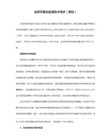
日本人在台湾的殖民同化政策之一是推行奴化教育。奴化教育主要措施:一是推行差别教育和普及日语。在初级教育阶段,日本人把学校分为小学校、公学校和教育所三种。小学校师资最强,设备最好,是供日本学童就读的;公学校师资和设备都比小学校差,专收台湾学童。台湾“蕃族”儿童进教育所学习,教育所根本谈不上什么设备,教学工作由警察担任。无论在什么学校,都把日语当作基本语言。禁读汉文,并通过修身、历史等课程向台湾学生灌输日本国体观念。学校的教师80%以上都是日本人。
奴化教育的另一措施是防止中国人接受高等教育。从中等教育开始,限制中国学生所学专业。总督府设立的程度较高的台北中学、台南中学和台北第一师范学校,都是专收日本学生的,不收台生的。在高等教育上,日本学生独占优势。 据统计,1928年台北帝国大学,日生49人,而台生仅6人;台北经济专门学校,日生338人,台生仅70人;台中农林学校日生94人,台生仅5人。教学内容更是以传播殖民主义文化为主,有关中国的历史、思想、文化均在排挤之列。1927年9月25日的《台湾民报》撰文抨击这种不合理的奴化教育,文章说:“将台湾人所负担的租税,建设维持学校,然而受教育的恩惠的学生,不但是以收容在台的日本学生为主,甚至每年由日本内地大批移入学生。如此使台湾人负担经费,而教育由日本内地移入的学生,此岂非明白的教育的榨取?”
1937年卢沟桥事变爆发,日本帝国主义发动了全面侵华战争,台湾成为日本帝国南进的最重要的战略基地。为了巩固这个基地,彻底奴役台湾人民,台湾日本殖民统治者根据近卫内阁(9)的“国民精神总动员计划”,制定了强迫全体台湾人民“皇民化”的方针。1937年9月30日,台湾殖民当局在台北市公会堂召开“(日本)国民精神总动员讲演会”,臭名昭著的“皇民化运动”就此开始。主要内容是,进行亲日思想宣传和精神动员,通过种种措施,极力消除台湾民众的祖国观念,灌输大日本臣民思想。1941年4月9日,殖民当局成立了“皇民奉公会”(10)。奉公会由时任总督的长谷川清(11)兼任总裁,自总督府到街庄都设有分会,并且均由当地的行政长官负责。此外,还成立了奉公团、青年学生报国会、青年奉公会、女青年奉公会、产业奉公会、核心俱乐部、模国挺身队等名目繁多的外围组织,作为推行“皇民化”的社会基础和基本力量。600万台湾民众都被纳入奉公会之内,强迫台人从骨子里消灭中国文化,而代以日本文化。
日本帝国主义殖民统治下的台湾地区阶级分析

日本帝国主义殖民统治下的台湾地区阶级分析李双龙;林宗弘【期刊名称】《社会》【年(卷),期】2016(036)004【摘要】本文利用台湾“中央研究院”的“历史人口计划”所提供的日据时期户籍数据库,运用新韦伯派阶级分类法,分析不同出生世代的阶级结构,并以多元逻辑回归统计模型估计其阶级流动的几率。
研究发现,无论在农业部门还是工业部门,越晚出生的世代(尤其是1895年后的出生者)无产阶级化的趋势越明显,而且糖业资本集中发展的中南部地区比北部地区更明显;其次,工业部门的本土雇主与自雇者大幅减少,显示日本垄断资本对台湾地区本土资本的竞争优势导致台湾地区工商业部门的无产化;第三,农业部门人口比例衰退的趋势在20世纪20年代之后逐渐稳定下来,这可能是“米糖相克”与家户生计逻辑造成的结果;第四,一方面受“农业台湾”的日本殖民政策限制,另一方面受家庭生计逻辑的影响,台湾地区的专业管理阶级或资本家在子女分户时仍经常划分农地给后嗣,因此出现了工业部门人口回流农业部门的向下流动的特殊现象,但已经靠农业就业的人口却难以流向工业部门。
本文的贡献在于重建历史资料来研究日据时期台湾地区的阶级流动,并呈现工业国家之外殖民地社会的阶级不平等。
【总页数】26页(P186-211)【作者】李双龙;林宗弘【作者单位】西南财经大学社会工作发展研究中心;台湾“中央研究院”社会学研究所【正文语种】中文【相关文献】1.日本帝国主义在沦陷区的殖民统治 [J], 柳合青2.日本帝国主义的殖民统治对赫哲族发展的影响 [J], 刘敏3.更新教育理念深化教学改革--以《日本帝国主义在沦陷区的殖民统治》指导学生写论文 [J], 李长余4.论总务厅在日本帝国主义对东北实施殖民统治中的作用 [J], 李慧娟;薛朝广5.论总务厅在日本帝国主义对东北实施殖民统治中的作用 [J], 李慧娟; 薛朝广因版权原因,仅展示原文概要,查看原文内容请购买。
日本殖民台湾时期经济政策在1937年前后之变化——以农业政策、鸦片政策为例

时期对ቤተ መጻሕፍቲ ባይዱ台实施 的经济 政策 。
一
展 以米糖输 出为轴 心相当有效率地发展着 ” 。
、
“日据前 期 ” 19 (85—13 97年 )
( 农业政策 : 农业 台湾 , 一) “ 工业 日本 ” 与英 国相 比 , 将殖 民地或半 殖 民地作 为其 原料 产地 和商 品销售市场 , 为本 国经 济服 务 , 日本有 过 之而无 不 及 。明治维新后 日本确立资本 主义 发展 道路 , 明治政 府 实行“ 殖产兴业 ” 的工业化政策 。特别是 10 9 5年 E俄战 t
甲午战败后 , 台湾作为 日本殖 民地被 占领和统治 长
达 5 年 之久 。在 这期 间 , 湾经济 自 而然 纳入 了 日 0 台 然 本帝国主义经济范 畴 , 成为 其原 料 产地 、 资本 投资 和商
品销售场所 。在二 战期 间台湾成 为 日本 “ 北并 进 ” 南 的 兵工厂 。那 么台湾经 济是 如何 被 纳入 到 了 日本 的殖 民 主义经济 圈内的?是 怎样 服务和依 附 于宗主 国 日本 的? 殖 民地经济性质 又是 怎样 体 现 出来 的?本文 拟从 农 业 政策 、 片政策 方面人手 , 鸦 探讨 日本在 1 3 前后对 台 9 7年
分, 因为凡是政策 的变 动 , 都有其 筹 备和策划 的时 间 , 是
一
府兴修了嘉南大圳等水利设施, 广泛普及蓬莱米等水稻
新 品种 , 扩大甘 蔗种植 面 积 , 且还 鼓励 日本企 业在 台 并
湾发展新 兴制糖 工 业 , 台湾 糖产 量迅 速 提高 , 使 成为 世 界上较大 的制 糖 中心 , 而形 成 了 以米 、 为 中心 的单 从 糖
粮食不足等 问题 , 民地 台湾首 当其 冲成 为牺牲 品。加 殖 上台 湾土 地肥 沃 、 候 温 和、 气 雨水 丰 沛 , 产水 稻 和甘 盛
台湾的历史演变与中国统一

台湾的历史演变与中国统一近年来,台湾问题成为了备受关注的焦点。
台湾作为中国的一部分,历经了漫长而曲折的历史发展,对于台湾与中国大陆的统一问题,人们有着不同的看法和观点。
本文将从历史的角度探讨台湾的演变过程以及中国统一的可能性。
一、荷兰殖民时期台湾最早的殖民者是荷兰人,他们于17世纪初期将台湾从西班牙人的手中夺取,并建立了台湾地区的荷兰殖民地。
然而,荷兰殖民时期并未对台湾产生深远的影响,其殖民统治也并未持续太久。
二、清朝统治1662年,明朝南明政权的鄭成功驱逐荷兰人,建立了“大明郑氏王朝”,进一步夺回了台湾。
随后,清朝统治者康熙帝重新收复台湾,将台湾纳入中国版图。
清朝时期,台湾作为福建省下属的一部分,享受了相对稳定的治理。
三、日本殖民统治19世纪末,日本国崛起为帝国主义国家,它利用甲午战争的胜利,通过《马关条约》向清朝取得台湾的割让权。
从1895年起,日本开始对台湾实行殖民统治,持续了达50年之久。
日本的统治给台湾带来了一定的现代化,但也给台湾带来了严重的剥削和压迫。
四、复归中国1945年,二战结束,日本正式宣布无条件投降,台湾由日本归还给中国。
然而,在1949年中华人民共和国成立后,国共内战的失败使得中国共产党只能退守到台湾,开创了台湾地区的地缘政治。
五、两岸对立国共内战结束后,蒋介石带领国民党政权撤退到台湾,建立了“中华民国”政府。
两岸对立的局面由此形成,台湾逐渐与大陆分离。
在国际上,随着中国共产党的接管大陆,并成为联合国常任理事国,台湾被孤立得越来越严重。
六、和平发展与两岸统一1987年,中国大陆实行改革开放政策,经济的快速发展加强了大陆与台湾的经济联系。
两岸关系逐渐缓和,形成了和平发展的局面。
然而,两岸的政治对立并未解决,台湾并未承认自己是中国的一部分,台湾民众对于统一问题分为两派,一派主张坚持独立,一派则主张与中国大陆和平统一。
中国的统一是历史的必然,这是从中国的历史和地理上来看的。
然而,实现和平统一是一项复杂而艰巨的任务,需要双方的共同努力和妥善的安排。
日本在台湾推行殖民统治的本质特征

日本在台湾推行殖民统治的本质特征冯 玮内容提要 《马关条约》后日本侵占台湾使之沦为殖民地,是“台湾独立”、“台湾地位未定”之类的论调得以产生的一个不可忽视的历史根源,认清台湾殖民地地位的“确定”以及日本在台湾推行的殖民统治的本质特征,不仅是对这类论调的有力驳斥,而且有助于认清日本殖民扩张的历史。
本文对日本在台湾逐步确定殖民统治政策的过程进行了扼要的历史考察,指出政治“存异”,即强调日本和台湾政治地位的不平等,以及文化“求同”,即通过灌输“皇道主义”精神培养台湾民众对日本的“认同意识”,是日本在台湾推行的殖民统治政策的本质特征。
这种特征是漫长的日本“西学”历程的政治结论,同时也是日本在朝鲜和“满洲国”推行的殖民统治政策的前导。
关键词 日本 台湾 殖民统治中国政府和人民一贯反对任何制造“两个中国”的阴谋,反对一切旨在将台湾分裂出中国的企图和阴谋。
然而多少年来,怀有这种企图和阴谋者仍不断鼓噪,谬论叠出。
众所周知,制造“两个中国”的论调有种种翻版,如鼓吹“一个中国,一个台湾”、“一个中国,两个政府”、“台湾地位未定”、“台湾独立”,等等。
但是,其本质却始终不变,即否认台湾是中国领土不可分割的一部分。
费正清在《美国与中国》一书中指出:“独立的台湾仍然是我们(美国)1949年以来对华政策的主要果实。
” 确实,在制造“两个中国”方面美国政府难辞其咎已是不争的事实。
这一“果实“不仅成为长期以来影响中美关系和中国对外关系的重要因素,而且使中国两岸骨肉同胞长期分离。
但是,如果我们进一步追溯产生“台湾问题”的历史却不难发现,其更深层的根源,是日本殖民扩张主义者使中国蒙受丧权辱国之耻的《马关条约》。
1950年6月27日,杜鲁门宣称:“台湾未来地位的决定必须等待太平洋安全的恢复、对日和约的签订或经由联合国的考虑” ,公开否认台湾是中国不可分割的一部分。
他这种公开制造“两个中国”的论调所依据的“法理”,就是因为《马关条约》后台湾曾沦为日本的“殖民地”。
不能高估日本殖民统治对台湾经济发展的作用——驳“殖民统治有益论”
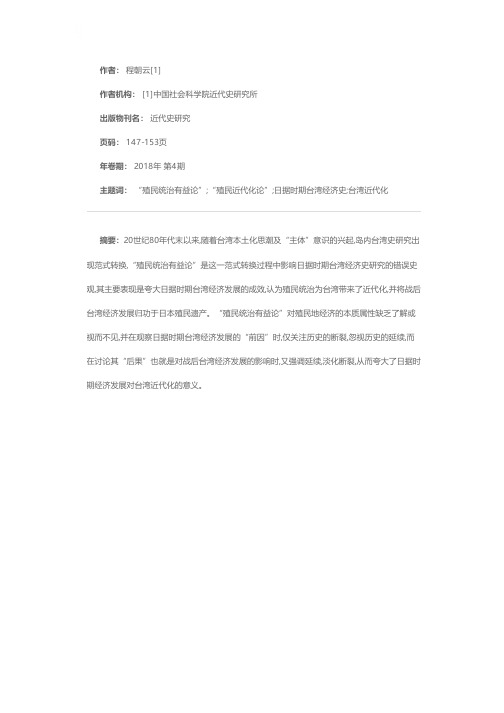
作者: 程朝云[1]
作者机构: [1]中国社会科学院近代史研究所
出版物刊名: 近代史研究
页码: 147-153页
年卷期: 2018年 第4期
主题词: “殖民统治有益论”;“殖民近代化论”;日据时期台湾经济史;台湾近代化
摘要:20世纪80年代末以来,随着台湾本土化思潮及“主体”意识的兴起,岛内台湾史研究出现范式转换,“殖民统治有益论”是这一范式转换过程中影响日据时期台湾经济史研究的错误史观,其主要表现是夸大日据时期台湾经济发展的成效,认为殖民统治为台湾带来了近代化,并将战后台湾经济发展归功于日本殖民遗产。
“殖民统治有益论”对殖民地经济的本质属性缺乏了解或视而不见,并在观察日据时期台湾经济发展的“前因”时,仅关注历史的断裂,忽视历史的延续,而在讨论其“后果”也就是对战后台湾经济发展的影响时,又强调延续,淡化断裂,从而夸大了日据时期经济发展对台湾近代化的意义。
- 1、下载文档前请自行甄别文档内容的完整性,平台不提供额外的编辑、内容补充、找答案等附加服务。
- 2、"仅部分预览"的文档,不可在线预览部分如存在完整性等问题,可反馈申请退款(可完整预览的文档不适用该条件!)。
- 3、如文档侵犯您的权益,请联系客服反馈,我们会尽快为您处理(人工客服工作时间:9:00-18:30)。
2
Ⅰ.殖民主義三種模式
The Japanese Colonial Rule in Taiwan
Cf. Ramon Myers and Mark Peattie, eds., The Japanese Colonial Empire, 1895-1945 (Princeton: Princeton University Press, 1984), pp. 4-14.
In the early 1930’s, FAs and SAUs employed 40,000 persons, of these 13,000 were gricultural advisers working with the SAUs at the village level, one extension worker for every 32 farm households. 15
Fertilizer 肥料 0 n 2n Tsailai 在萊米 x x+12% x+6% Ponglai #65 蓬萊米 y y+30% y+44%
14
2. New Rural Institutions: Extension Service System 農村新機構: 農業推廣系統
a) Farmers’ Associations(農會): One in every prefecture since 1900s. b) Small Agricultural Units(農業小組): Several thousands. c) Credit Cooperatives(信用合作社): 13 (1913), 214(1920), 332 (1930), 443 (1940).
11
12
Ⅴ.日本時期的台灣經濟發展
A.農業發展 Technological Change in Agriculture (1900-1945)
1. Modern Agricultural Science The Taiwan Agricultural Research Institute, established in 1903, followed by district agricultural improvement stations. Successful adaptation of seeds with higher yields, greater resistance to disease and high wind, and more receptivity to fertilizer and intensive care. Sugar Cane: native bamboo cane rose bamboo cane from Hawaii: minor improvements. 1920s, new cane varieties with average yield more than twice and sugar content 40% higher.
6
Ⅲ.日本治台政策辯論
Japanese Policy Debates
1. Law # 63 (六三法) (March 30, 1896) gave the Governor-General a special authority to issue executive ordinances “having the same effect as the law of Japan.” 2. 特別統治主義 3. 內地延長主義
X and H: a primary sector, with agriculture its main economic activity. N: a small, emerging non-agricultural sector of services (trade, financial services, transportation and communication) with some manufacturing. J: primary exports. M: manufactured imports. C: commercial services. N supplies X with manufactured goods and commercial services.
The Taiwan Affairs Bureau (Taiwan Jimukyoku 台灣事務局)
The TAB met in June 1895 to discuss the management of Taiwan.
Michel Lubon, a French adviser, recommended that Taiwan be regarded as a prefecture of Japan in the future, if not now, and that those sections in the Japanese constitution that related to the people’s rights and liberties, and criminal law be implemented at once in the new territory. Lubon asked the Japanese government to follow the example of French relations with Algeria.
日本在台灣的殖民統 治: 經濟發展
高雄醫學大學 通識教育中心 客座教授 蕭欣義
1
日本在台灣的殖民統治: 經濟發展(大綱)
I. II. III. IV. V. VI. 殖民主義的三種模式 外籍顧問給「台灣事務局」的建議 日本治台政策辯論 殖民地時代的台灣經濟如何評估? 日本時期的台灣經濟發展 公共衛生的改進
A. Comparative Colonialism: Three Major Models of Colonialism 1) The British Model: Allowed the possibility of
autonomous development of the emperium’s various components, while still bearing the common burden of trusteeship.
Foreign trade sector
F
M
J
Primary-export sector
N C
X
H
Primary sector
Enclave
Hinterland or subsistence sector
Dualistic Economy
10
Source: Samuel Ho, “Colonialism and Development: Korea, Taiwan, and Kwantung,” in Ramon Myers and Mark Peattie, eds.,The Japanese Colonial Empire, 1895-1945 (Princeton: Princeton University Press, 1984), p. 381. The above figure is borrowed, with some minor modification, from Douglas A. Paauw and John C. H. Fei, The Transition in Open Dualistic Economies (New Haven: Yale University Press, 1973), p. 4
3
2) The French Model: France, drawing on the
republican principles of 1789, which its statesmen and thinkers believed were applicable in all times and places, held to the theory (though less in practice) that her colonies were parts of an indivisible republic whose global purpose was a mission civilisatrice, the propagation of French civilization. 3) The German Model: creation of a “scientific colonialism.” This approach was based on the German passion for methodical research and investigation, both of which were seen as prerequisites for economically sound administration and maximum efficiency in the extraction of wealth from colonial territories.
13
Rice Seeds:
Tsailai rice (在萊米): 1,379 kg/ha [hectare公頃=2.47 acres 英畝] Ponglai rice (蓬萊米) #1 Nakamura (中村), 1924: 1,594kg/ha Ponglai rice, Taichung (台中) #65, 1926, 1930s: 1,935kg/ha
5
A different view was submitted by Montague Kirkwood, a British adviser. He made clear that it would be to the advantage of both Japan and the people of Taiwan to regard the island as a colony, legally, politically, culturally, and financially separate from Japan, in the same way that the British colonies of India and Hong Kong were separated from Great Britain. He recommended that the Japanese government create a legislative council in Taiwan, appointed by the governor-general, with himself as ex-officio president, to enact necessary colonial laws. He also urged the appointment of several Taiwanese as its members. He also suggested the appointment of as many Taiwanese as possible as local administrators and judges. The TAB accepted the French proposal, but the TAB was disbanded in April 1896.
